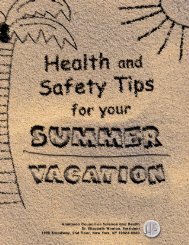Health and Safety Tips for Your Summer Vacation (Update 2010)
Health and Safety Tips for Your Summer Vacation (Update 2010)
Health and Safety Tips for Your Summer Vacation (Update 2010)
You also want an ePaper? Increase the reach of your titles
YUMPU automatically turns print PDFs into web optimized ePapers that Google loves.
Uncovering only one part of the pool has led<br />
to accidents in which people surfaced under<br />
the cover <strong>and</strong> drowned.<br />
• Do not use the telephone if you are in the pool<br />
(or the bathtub or shower, <strong>for</strong> that matter). If<br />
you drop the phone in the water you could get<br />
a serious electrical shock. (This warning does<br />
not apply to cordless phones. If you drop a<br />
cordless phone in the water, you may damage<br />
the phone, but you will not hurt yourself.)<br />
• Read <strong>and</strong> follow our <strong>Tips</strong> <strong>for</strong> Safe Swimming<br />
<strong>and</strong> Diving, above.<br />
• Ask your pool’s manufacturer what kind of<br />
diving board, if any, is appropriate.<br />
<strong>Safety</strong> <strong>Tips</strong> <strong>for</strong> Ponds <strong>and</strong> Swimming<br />
Holes<br />
• Mark off safe swimming areas with buoyed<br />
lines.<br />
• Remove underwater debris, such as bottles <strong>and</strong><br />
cans, from swimming areas.<br />
• Do not use areas near steeply sloping banks <strong>for</strong><br />
swimming.<br />
• Post warning signs in dangerous areas where<br />
people should not swim.<br />
• Have the water checked <strong>for</strong> chemical <strong>and</strong> sanitary<br />
quality <strong>and</strong> approved by the local health<br />
department.<br />
• Make sure that floats, diving boards, piers, <strong>and</strong><br />
similar structures are well built <strong>and</strong> securely<br />
anchored in place.<br />
• Post emergency instructions, emergency telephone<br />
numbers, <strong>and</strong> rules <strong>for</strong> the swimming<br />
area.<br />
• Read <strong>and</strong> follow the <strong>Tips</strong> <strong>for</strong> Safe Swimming<br />
<strong>and</strong> Diving, above.<br />
<strong>Safety</strong> <strong>Tips</strong> <strong>for</strong> Beaches<br />
• Swim in areas supervised by lifeguards.<br />
• If you get caught in a current, swim with it or<br />
diagonally across it until you can get free or<br />
call <strong>for</strong> help. Do not attempt to swim against a<br />
current.<br />
• Do not use breakable objects on the beach.<br />
• Do not leave children unattended, even in<br />
areas where lifeguards are on duty.<br />
• If you want to try a long-distance swim, swim<br />
parallel to the shore <strong>and</strong> close enough to the<br />
shore so that you can reach it easily.<br />
• Do not strike up conversations with lifeguards<br />
or interfere in any other way with the per<strong>for</strong>mance<br />
of their jobs.<br />
• Read <strong>and</strong> follow the <strong>Tips</strong> <strong>for</strong> Safe Swimming<br />
<strong>and</strong> Diving, above.<br />
<strong>Safety</strong> <strong>Tips</strong> <strong>for</strong> Boating<br />
• All boat occupants should wear Coast Guardapproved<br />
life jackets.<br />
• Know the “rules of the road” of the area in<br />
which you are boating.<br />
• Remember that alcohol <strong>and</strong> driving don’t<br />
mix—whether the vehicle is a car, powerboat,<br />
jet ski, or canoe.<br />
Protective Gear<br />
The combination of sunny days <strong>and</strong> warm temperatures<br />
often means that people (especially<br />
children) want to wear as little as possible when<br />
engaging in outdoor activities. One item of<br />
apparel that should not be omitted, however, is<br />
the protective helmet. Whether used <strong>for</strong> bicycle<br />
riding, horseback riding, or in-line skating, properly<br />
fitting helmets can prevent serious <strong>and</strong><br />
often life-threatening head injuries. According to<br />
the Centers <strong>for</strong> Disease Control <strong>and</strong> Prevention<br />
(CDC), each year more than 700 people die as<br />
a result of bicycle-related injuries, mostly head<br />
injuries. A study in Seattle in 1989 revealed that<br />
the use of helmets reduced the risk <strong>for</strong> bicyclerelated<br />
head injury by between 74 <strong>and</strong> 85 percent.<br />
• Riders should choose light-colored helmets that<br />
are easier to see at dusk or at night.<br />
• A helmet should have a hard outer shell <strong>and</strong><br />
a crushable liner, <strong>and</strong> should fit snugly, with<br />
straps to keep it securely in place.<br />
• Bicycle helmets should carry a label indicating<br />
that they have been approved by the Snell<br />
Memorial Foundation, American National<br />
St<strong>and</strong>ards Institute (ANSI), or American<br />
St<strong>and</strong>ards Testing Materials (ASTM).<br />
Other sports will require other types of protective<br />
gear in addition to helmets. For example, in-<br />
4










